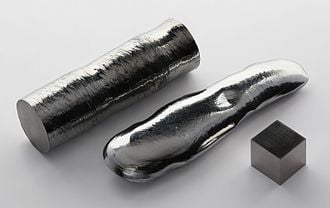Rhenium

Rhenium is a chemical element with the symbol Re and atomic number 75. It is a silvery-gray, heavy, third-row transition metal in group 7 of the periodic table. With an estimated average concentration of 1 part per billion (ppb), rhenium is one of the rarest elements in the Earth’s crust.
Rhenium has the third-highest melting point and second-highest boiling point of any stable element at 5903 K.[4] Rhenium resembles manganese and technetium chemically and is mainly obtained as a by-product of the extraction and refinement of molybdenum and copper ores. Rhenium shows in its compounds a wide variety of oxidation states ranging from −1 to +7.
Discovered in 1908, rhenium was the second-last stable element to be discovered (the last being hafnium). It was named after the river Rhine in Europe.
Nickel-based superalloys of rhenium are used in the combustion chambers, turbine blades, and exhaust nozzles of jet engines. These alloys contain up to 6% rhenium, making jet engine construction the largest single use for the element. The second-most important use is as a catalyst: rhenium is an excellent catalyst for hydrogenation and isomerization, and is used for example in catalytic reforming of naphtha for use in gasoline (rheniforming process).
Because of the low availability relative to demand, rhenium is expensive, with price reaching an all-time high in 2008/2009 of US$10,600 per kilogram (US$4,800 per pound). Due to increases in rhenium recycling and a drop in demand for rhenium in catalysts, the price of rhenium has dropped to US$2,844 per kilogram (US$1,290 per pound) as of July 2018.
